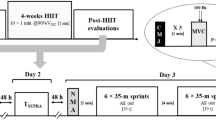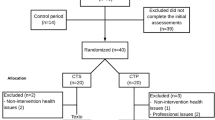Abstract
Purpose
The aim of this study was to compare the effects of 8 weeks of resistance training (RT) and high-intensity interval training (HIIT) on muscle strength, muscle power and cardiorespiratory responses in trained young men.
Methods
Twenty-two men [RT (n = 11); HIIT (n = 11)] performed 8 weeks of training, with frequency of 2 times per week. RT group performed 10 sets × 10–12 RM of Leg-press exercise, while HIIT group performed 10 sets of running × 60 s at 85–95% of maximal heart rate. Both groups performed 60 s of passive rest between sets. Maximal strength (one-repetition maximum [1RM] of Leg Press and Knee Extension), jump height (single-leg countermovement jump) and cardiorespiratory responses during Conconi Test (predicted VO2peak and heart rate at maximal and at deflection point) were evaluated at baseline and after training program.
Results
1RM of Leg Press increased in both training groups (p < 0.001), with higher gains in the RT group (RT = 32.2%, HIIT = 9.5%; p = 0.036; d = 1.86), 1RM of Knee Extension did not improve for either group (p = 0.065). Only the HIIT group improved jump height (RT = − 1.5%, HIIT = 14.2%; p = 0.002; d = 1.52) and cardiorespiratory capacity (RT = − 1.1%, HIIT = 3.2%; p = 0.006; d = 1.27).
Conclusion
Despite RT group promoting higher strength gains, HIIT is also effective for improving strength, jump height and cardiorespiratory capacity, and it presents as a possible alternative for people who seek improvements in health variables.
Trial registration
This study was registered in Brazilian Clinical Trials Registry (registration number RBR-7n8y9ky) on Mar 09th 2021 (retrospectively registered).



Similar content being viewed by others
Availability of data and materials
Not applicable.
Code availability
Not applicable.
References
Garber CE et al (2011) Quantity and quality of exercise for develo** and maintaining cardiorespiratory, musculoskeletal, and neuromotor fitness in apparently healthy adults: guidance for prescribing exercise. Med Sci Sports Exerc 43(7):1334–1359
Loprinzi PD (2015) Dose–response association of moderate-to-vigorous physical activity with cardiovascular biomarkers and all-cause mortality: considerations by individual sports, exercise and recreational physical activities. Prev Med 81:73–77
Evans JW (2019) Periodized resistance training for enhancing skeletal muscle hypertrophy and strength: a mini-review. Front Physiol 10:13
Brooks GA (2011) Bioenergetics of exercising humans. comprehensive. Physiology 2(1):537–562
Pollock ML et al (1998) ACSM position stand: the recommended quantity and quality of exercise for develo** and maintaining cardiorespiratory and muscular fitness, and flexibility in healthy adults. Med Sci Sports Exerc 30(6):975–991
Tjønna AE et al (2013) Low-and high-volume of intensive endurance training significantly improves maximal oxygen uptake after 10-weeks of training in healthy men. PLoS One 8(5):e65382
Reljic D et al (2021) Effects of very low volume high intensity versus moderate intensity interval training in obese metabolic syndrome patients: a randomized controlled study. Sci Rep 11(1):2836
Gibala MJ, Mcgee SL (2008) Metabolic adaptations to short-term high-intensity interval training: a little pain for a lot of gain? Exerc Sport Sci Rev 36(2):58–63
Buchheit M, Laursen PB (2013) High-intensity interval training, solutions to the programming puzzle. Part II: anaerobic energy, neuromuscular load and practical applications. Sports Med 43(10):927–954
Wilson JM et al (2012) The effects of endurance, strength, and power training on muscle fiber type shifting. J Strength Cond Res 26(6):1724–1729
Martinez-Valdes E et al (2017) Differential motor unit changes after endurance or high-intensity interval training. Med Sci Sports Exerc 49(6):1126–1136
García-Pinillos F et al (2017) A high intensity interval training (HIIT)-based running plan improves athletic performance by improving muscle power. J Strength Cond Res 31(1):146–153
Depiazzi JE et al (2019) The effect of aquatic high-intensity interval training on aerobic performance, strength and body composition in a non-athletic population: systematic review and meta-analysis. Clin Rehabil 33(2):157–170
Steele J et al (2012) Resistance training to momentary muscular failure improves cardiovascular fitness in humans: a review of acute physiological responses and chronic physiological adaptations. J Exerc Physiol Online 15(3):53–80
Hughes DC et al (2018) Adaptations to endurance and strength training. Cold Spring Harb Perspect Med 8(6):a029769
Fisher J, Steele J (2014) Questioning the Resistance/Aerobic Training Dichotomy: a commentary on physiological adaptations determined by effort rather than exercise modality. J Hum Kinet 44(1):137–142
Steele J et al (2018) Similar acute physiological responses from effort and duration matched leg press and recumbent cycling tasks. PeerJ 6:e4403
Callahan MJ et al (2021) Skeletal muscle adaptive responses to different types of short-term exercise training and detraining in middle-age men. Med Sci Sports Exerc 53:2023–2036
Altenburg TM et al (2007) Recruitment of single muscle fibers during submaximal cycling exercise. J Appl Physiol 103(5):1752–1756
Biglari S et al (2020) High-intensity interval training-induced hypertrophy in gastrocnemius muscle via improved IGF-I/Akt/FoxO and myostatin/Smad signaling pathways in rats. Physiol Int. https://doi.org/10.1556/2060.2020.00020
Schjerve IE et al (2008) Both aerobic endurance and strength training programmes improve cardiovascular health in obese adults. Clin Sci 115(9):283–293
Vilaça-Alves J et al (2016) Comparison of oxygen uptake during and after the execution of resistance exercises and exercises performed on ergometers, matched for intensity. J Hum Kinet 53(1):179–187
Piantadosi S (2017) Clinical trials: a methodologic perspective. John Wiley and Sons
Conconi F et al (1982) Determination of the anaerobic threshold by a noninvasive field test in runners. J Appl Physiol 52(4):869–873
Conconi F et al (1997) The Conconi test: methodology after 12 years of application. Occup Health Indus Med 1(36):43
Bodner ME, Rhodes EC (2000) A review of the concept of the heart rate deflection point. Sports Med 30(1):31–46
Wyss T et al (2019) Development of physical fitness performance in young Swiss men from 2006 to 2015. Scand J Med Sci Sports 29(4):586–596
Wyss T et al (2007) Assembling and verification of a fitness test battery for the recruitment of the Swiss army and nation-wide use. Swiss J Sports Med Sports Traumatol 55(4):126–131
Brown LE, Weir JP (2001) ASEP procedures recommendation i: accurate assessment of muscular strength and power. Professional Exerc Physiol. 4(11):1–21
Botton CE et al (2016) Neuromuscular adaptations to unilateral vs bilateral strength training in women. J Strength Cond Res 30(7):1924–1932
Vescovi JD, McGuigan MR (2008) Relationship between sprinting, agility, and jump ability in female athletes. J Sports Sci 26(1):97–107
Dal Pupo J et al (2014) Reliability and validity of the 30-s continuous jump test for anaerobic fitness evaluation. J Sci Med Sport 17(6):650–655
Steele J et al (2017) Clarity in reporting terminology and definitions of set endpoints in resistance training. Muscle Nerve 56(3):368–374
Schoenfeld BJ et al (2016) Longer interset rest periods enhance muscle strength and hypertrophy in resistance-trained men. J Strength Cond Res 30(7):1805–1812
Jung ME et al (2015) High-intensity interval training as an efficacious alternative to moderate-intensity continuous training for adults with prediabetes. J Diabetes Res 2015:191595
Cohen, J (1988) Statistical power analysis for the behavioral sciences, 2nd edn, Hillsdale, NJ
Nuell S et al (2021) Hamstring muscle volume as an indicator of sprint performance. J Strength Cond Res 35(4):902–909
Martín-Fuentes I et al (2020) Evaluation of the lower limb muscles’ electromyographic activity during the leg press exercise and its variants: a systematic review. Int J Environ Res Public Health 17(13):4626
Grgic J et al (2018) Effects of rest interval duration in resistance training on measures of muscular strength: a systematic review. Sports Med 48(1):137–151
Lopez P et al (2021) Resistance training load effects on muscle hypertrophy and strength gain: systematic review and network meta-analysis. Med Sci Sports Exerc 53(6):1206–1216
Ozaki H et al (2015) Cycle training induces muscle hypertrophy and strength gain: strategies and mechanisms. Acta Physiol Hung 102(1):1–22
Kyröläinen H, Avela J, Komi PV (2005) Changes in muscle activity with increasing running speed. J Sports Sci. 23(10):1101–9
Higashihara A et al (2010) Functional differences in the activity of the hamstring muscles with increasing running speed. J Sports Sci 28:1085–1092
Blackburn JR, Morrissey MC (1998) The relationship between open and closed kinetic chain strength of the lower limb and jum** performance. J Orthopedic Sports Phys Ther. 27(6):430–5
Malisoux L et al (2006) Stretch-shortening cycle exercises: an effective training paradigm to enhance power output of human single muscle fibers. J Appl Physiol 100(3):771–779
Sáez de Villarreal E et al (2012) The effects of plyometric training on sprint performance: a meta-analysis. J Strength Cond Res 26(2):575–584
Ross A et al (2001) Neural influences on sprint running. Sports Med 31(6):409–425
Sarabia JM et al (2017) The effects of training with loads that maximize power output and individualised repetitions vs traditional power training. PLoS One. 12(10):e0186601
Nes BM et al (2013) Age-predicted maximal heart rate in healthy subjects: The HUNT Fitness Study. Scand J Med Sci Sports 23(6):697–704
Macinnis MJ, Gibala MJ (2017) Physiological adaptations to interval training and the role of exercise intensity. J Physiol 59(9):2915–2930
Baroni BM et al (2013) Time course of neuromuscular adaptations to knee extensor eccentric training. Int J Sports Med 34(10):904–911
Maffiuletti NA et al (2016) Rate of force development: physiological and methodological considerations. Eur J Appl Physiol 11(6):1091–1116
Funding
This research received no specific grant from any funding agency in the public, commercial, or not-for-profit sectors.
Author information
Authors and Affiliations
Contributions
TM: the conception, acquisition of data, analysis and interpretation of data, draft of the article revising it critically for important intellectual content and final approval of the version to be submitted. TM: acquisition of data, data analysis, critical revision of the article, draft of the article revising it critically for important intellectual content and final approval of the version to be submitted; RR: analysis and interpretation of data, draft of the article revising it critically for important intellectual content, final approval of the version to be submitted; RR: the conception and design of the study, study orientation and supervision and critical revision of the article, final approval of the version to be submitted and correspondent author. All authors contributed equally to the manuscript and read and approved the final version of the manuscript.
Corresponding author
Ethics declarations
Conflict of interest
Authors declared no conflict of interest.
Ethical approval
The study was approved by the University's Research and Ethics Committee (n: 2.319.112). This study followed all ethical principles contained in the Helsinki Declaration.
Consent to participate
Before starting, all participants were informed of the aims and procedures of the study and signed an informed consent form.
Consent for publication
Not applicable.
Additional information
Publisher's Note
Springer Nature remains neutral with regard to jurisdictional claims in published maps and institutional affiliations.
Rights and permissions
About this article
Cite this article
Molinari, T., Molinari, T., Rabello, R. et al. Effects of 8 weeks of high-intensity interval training or resistance training on muscle strength, muscle power and cardiorespiratory responses in trained young men. Sport Sci Health 18, 887–896 (2022). https://doi.org/10.1007/s11332-021-00872-2
Received:
Accepted:
Published:
Issue Date:
DOI: https://doi.org/10.1007/s11332-021-00872-2




